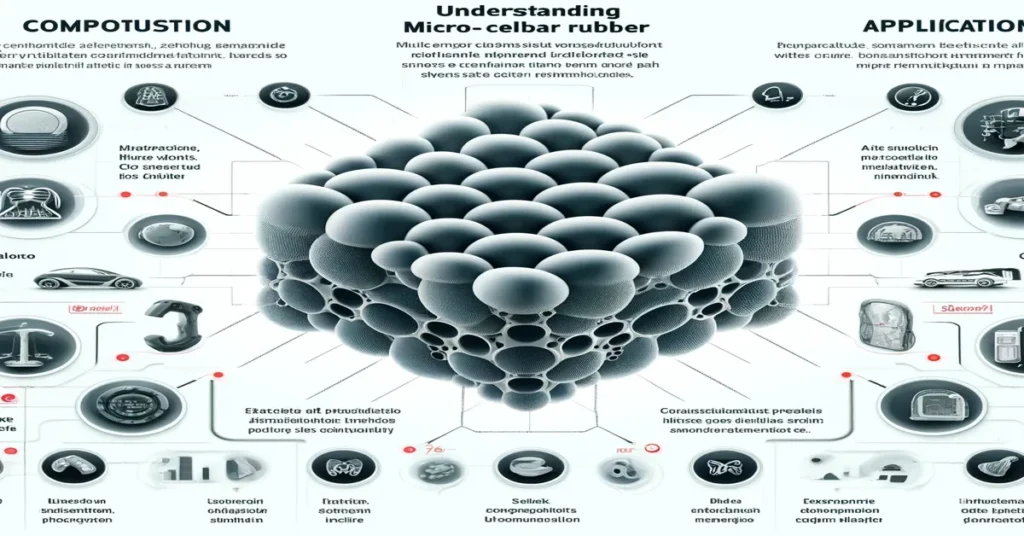Micro cellular rubber, also known as microcellular rubber or microcellular foam rubber, is a unique and versatile material used across various industries, from automotive to footwear. Known for its lightweight, flexible, and durable properties, micro cellular has revolutionized applications that demand a high degree of resilience, insulation, and comfort. This material’s structure, characterized by tiny cells, offers an array of benefits, including shock absorption, water resistance, and thermal insulation, making it ideal for applications in conditions that demand rugged and flexible materials.
This article delves into the properties, types, manufacturing processes, applications, and advantages of micro cellular By the end, you’ll have a comprehensive understanding of how this material works, why it’s so widely used, and what future innovations in micro cellular rubber might look like.
1. What is Micro Cellular Rubber?
Micro cellular is a form of expanded rubber featuring a high density of small, closed cells that contribute to its distinctive properties, such as low density, flexibility, and high resilience. The micro cellular structure in this material is engineered to trap air within the cells, reducing the rubber’s weight while enhancing its cushioning properties.
This material can be made from a variety of rubber compounds, including natural rubber, ethylene propylene diene monomer (EPDM), and polyurethane (PU), among others. The unique characteristics of each compound can modify the properties of the final micro cellular product, allowing manufacturers to tailor it for specific applications.
2. Properties of Micro Cellular Rubber
Micro cellular exhibits various properties that make it an ideal material for numerous applications. Here are some of its most notable features:
2.1 Lightweight
The air-filled cell structure significantly reduces the material’s weight, making it perfect for applications where minimizing weight is crucial, such as footwear and automotive parts.
2.2 Cushioning and Shock Absorption
The compressible cells allow micro cellular to absorb shocks effectively, making it ideal for protective applications in sports gear, footwear, and automotive components.
2.3 Thermal Insulation
The trapped air in the closed cells acts as an insulator, making this material suitable for thermal applications, such as in building insulation and heat shields in automotive parts.
2.4 Sound Insulation
Micro cellular also offers sound insulation properties, making it valuable for applications in automotive and construction where noise reduction is desirable.
2.5 Water and Chemical Resistance
Micro cellular especially when made with compounds like EPDM, exhibits resistance to water, oils, and chemicals, adding to its versatility and durability in harsh environments.
2.6 Flexibility and Durability
Despite being lightweight, micro cellular is durable and maintains flexibility over a range of temperatures and conditions, which adds to its lifespan and reliability.
3. Types of Micro Cellular Rubber
Micro cellular can be categorized into different types based on the base material used, each with unique properties suited for specific applications.
3.1 EPDM Micro Cellular Rubber
Ethylene Propylene Diene Monomer (EPDM) is known for its weather and ozone resistance. EPDM micro cellular is widely used in outdoor applications, automotive weather stripping, and sealing applications.
3.2 Natural Rubber Micro Cellular Foam
Natural rubber-based micro cellular foam is often preferred for applications that require high elasticity and resilience. However, it may have limitations in terms of aging and environmental resistance compared to synthetic counterparts.
3.3 Polyurethane (PU) Micro Cellular Rubber
Polyurethane micro cellular is commonly used in footwear and sports equipment due to its excellent wear resistance and cushioning properties.
3.4 Neoprene Micro Cellular Rubber
Neoprene-based micro cellular provides excellent chemical resistance and is commonly used in applications where exposure to oils, solvents, and extreme temperatures is expected.
3.5 Silicone Micro Cellular Rubber
Silicone-based micro cellular is highly heat resistant and is often used in medical, automotive, and aerospace applications due to its stability over a wide temperature range.
4. Manufacturing Process of Micro Cellular Rubber
The manufacturing process for micro cellular typically involves several key steps designed to ensure the material’s unique cell structure and characteristics. The process varies slightly depending on the type of base rubber, but the general steps are as follows:
4.1 Mixing and Compounding
The first step involves mixing the chosen rubber compound with additives and blowing agents. These blowing agents create the cellular structure by releasing gas during the curing process.
4.2 Molding and Shaping
The compounded material is then placed in molds where it takes on the desired shape. This is an important step for ensuring that the micro cellular fits the specific design requirements of the application.
4.3 Curing and Vulcanization
The molding process is followed by curing or vulcanization, where heat is applied to activate the blowing agents. This step creates the microcellular structure, as the gas released by the blowing agents forms bubbles in the rubber matrix.
4.4 Cooling and Finishing
Once cured, the rubber is cooled and removed from the mold. It may then undergo additional finishing processes, such as trimming, to prepare it for its intended application.
5. Applications of Micro Cellular Rubber
Micro cellular unique properties make it suitable for a wide range of applications across various industries.
5.1 Automotive Industry
In the automotive sector, micro cellular is used in applications such as seals, gaskets, and weather stripping. Its cushioning properties make it an excellent choice for reducing noise and vibration, while its water and heat resistance ensure durability in extreme conditions.
5.2 Footwear Industry
Footwear, particularly athletic and orthopedic shoes, benefits significantly from micro cellular. Its lightweight nature and cushioning properties help in shock absorption and provide comfort, enhancing overall footwear performance.
5.3 Construction Industry
Micro cellular is used for insulation in the construction industry, providing both thermal and sound insulation. Its water resistance also makes it suitable for weather stripping in doors and windows.
5.4 Electronics and Appliance Industry
Micro cellular is used in the electronics industry for sealing and cushioning components. It is commonly found in applications requiring dust or moisture sealing, such as in air conditioners and refrigerators.
5.5 Medical Devices
The medical industry uses micro cellular for orthopedic supports and prosthetics due to its comfort and cushioning properties. Additionally, silicone-based micro cellular is used in medical-grade seals and gaskets.
6. Advantages of Micro Cellular Rubber
Micro cellular offers several advantages over traditional solid rubber, including:
6.1 Enhanced Comfort
The lightweight and cushioned properties make it comfortable for applications in footwear and medical supports.
6.2 Durability and Longevity
Micro cellular is resilient and retains its properties over time, even under stress, heat, and moisture exposure.
6.3 Customizability
Manufacturers can adjust the cell size, density, and composition to meet specific needs, allowing for versatility in a range of applications.
6.4 Cost Efficiency
Micro cellular is often more economical in applications requiring light materials, such as automotive components and insulation, reducing overall material and transportation costs.
7. Future of Micro Cellular Rubber
Innovations in material science are expected to improve micro cellular properties and expand its applications. Developments in eco-friendly and biodegradable compounds may provide alternatives that retain the same functionality but with a reduced environmental impact. Additionally, ongoing research aims to improve the strength-to-weight ratio and resilience of micro cellular, making it an even more versatile material for future applications.
Conclusion
Micro cellular stands out as an essential material in many industries due to its unique combination of light weight, cushioning, flexibility, and resistance properties. From automotive seals to shoe soles, this material’s adaptability ensures it remains in high demand. As technology advances, the future holds potential for further innovations, making micro cellular an even more valuable asset across various sectors.
FAQs
1. What is micro cellular rubber?
Micro cellular is a lightweight, expanded rubber material with small, closed cells that provide cushioning, flexibility, and resistance to water, chemicals, and extreme temperatures.
2. Where is micro cellular rubber commonly used?
Micro cellular is widely used in the automotive, footwear, electronics, and construction industries, particularly for applications requiring cushioning, insulation, or waterproofing.
3. What makes micro cellular rubber different from solid rubber?
Unlike solid rubber, micro cellular has tiny air-filled cells that reduce its weight and enhance shock absorption and insulation properties, making it ideal for lightweight, resilient applications.
4. Can micro cellular rubber be customized for specific applications?
Yes, manufacturers can tailor micro cellular by adjusting the base material, cell density, and size, making it highly adaptable for various specialized applications.
5. Is micro cellular rubber environmentally friendly?
Traditional micro cellular may not be biodegradable, but ongoing research is focused on developing eco-friendly alternatives that offer the same properties with reduced environmental impact.
6. How is micro cellular rubber made?
The material is created by mixing rubber compounds with blowing agents, molding, and curing them under heat, which creates the characteristic cellular structure filled with air pockets.







